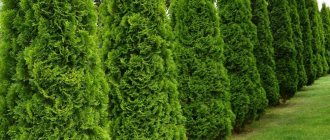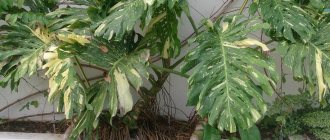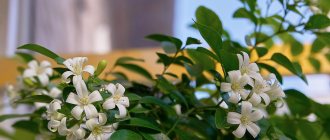Among evergreens, Thuja is distinguished not only by its species diversity, but also by its ease of reproduction. Methods of both seed propagation and cuttings are applicable to most conifers. However, the first method does not guarantee the preservation of maternal characteristics, since the potential for cross-pollination between different varieties and species remains. Propagation of Thuja by cuttings was also chosen as a basis due to the high percentage of rooting, effectiveness and a fairly easy procedure even for a beginner. Let's look at this issue in more detail.
Reproduction of Thuja by cuttings in summer
Most experts call the most favorable period for cuttings the end of May - mid-June. But, the main criterion for a suitable period is the cessation of shoot growth.
To do this, use a plant of the required shape and color. There are columnar, spreading, ornate trees and bushes, but you should definitely check the plant for parasites and diseases in order to prevent possible problems with conifers from spreading to other inhabitants of the garden and eliminating all efforts due to the death of the cutting.
Preparation of Thuja cuttings
Thuja cuttings must have a heel.
The material from the mother plant is extracted in the same way, regardless of the season:
- We select the future cutting from the top of the bush. This is where the skeletal branches are located, among which they make a choice for optimal development and appearance. Ideal would be 2-3 year old and already lignified growths of 10-15 cm.
- We tear it off from top to bottom with a sharp movement, grabbing the “heel” - the wood with the bark. The size of the heel is not so important, but if the bark peels off from it, then this part is trimmed a little, since it will only rot and will not allow activation of root formation. A normal “heel” contains substances accumulated by the mother plant that are useful for the sprout.
- It is recommended to trim the branches along the edges of the cuttings, but more important is to remove the branches from the lower part so that they do not rot when they get into the ground or water.
- Before planting in a container, the cuttings are dipped in a root system growth stimulator (for example, Kornevin) for several hours.
The advantage of summer cuttings is the ability to provide optimal (22-25°C) temperature conditions due to warm weather. It is not recommended to save cuttings without planting them in a suitable substrate. But if it is not possible to plant immediately (for example, when collecting cuttings far from your home), their lower part is wrapped in a cloth previously moistened with water.
Preparing containers for Thuja cuttings
Next, select a container for the stalk. It can be standard containers for seedlings, a cut-off plastic bottle (the bottom is filled with soil and the top is covered), and a plastic cup (the second one is used as a shelter).
Those who perceive the cultivation of Thuja as a business idea install special greenhouses with a metal or wooden frame and two-layer film. But stationary nurseries should be placed with caution. The fact is that accumulated evaporation is detrimental to sprouts, as are direct sunlight. The best location is in partial shade.
But to accommodate 4-6 cuttings, a trimmed 5 liter water bottle is also suitable, since sprouts can be planted after 5 cm. It is convenient to water and ventilate in such a container by simply unscrewing the lid.
Soil preparation
It is important to select the required composition of the mixture for growing. Don’t forget that conifers need acidic, loose soil.
It can be either river sand or a composition of 3 components in equal quantities - sand, high-moor peat and forest soil. The latter is collected not from the dried top layer, but deeper. It contains mushrooms that help conifers grow. You can also add perlite.
Within a month, with proper care, you can observe the appearance of new branches, which indicates successful rooting. Picking is carried out only during group planting (if all the cuttings have taken root and their rhizomes can intertwine). Further care consists of permanent watering when the top layer dries for about 2 years.
An important point when planting cuttings in a container for rooting is correct planting depending on the direction of the world. The needles, like an ordinary leaf, have a front side (facing the sun) and a back side. If the sun exposes the back side of the needles of a cutting and not the front, then the cutting will simply burn. Remember that cuttings must be planted so that the front side always faces south.
You can learn more about propagating Thuja by cuttings from this video
When to cut thuja: optimal timing
Different gardeners and gardeners carry out cuttings at different times: some in winter (February), some in spring, some in summer. And their opinions - when it is best to do this - also differ.
But the most popular option for performing the procedure among many summer residents is summer. Propagation by this method during this period allows the cuttings to take root well by next year.
However, you can choose the timing of cuttings that is most convenient for you.
In this case, you need to cut the cuttings after the shoots stop growing.
Thuja cuttings in winter
Proponents of this season for cuttings give their reasons:
- By analogy with seeds, cuttings undergo a certain stratification and are more resistant to climate change;
- You don’t have to worry that the sprouts will get sunburned or overheated.
But there is also a more pragmatic approach - in winter there is much less work to do in the garden and you can start propagating interesting conifers.
You should carefully consider the location of the cuttings to ensure an influx of fresh, but not cold air, as well as a temperature of at least 22 degrees C, otherwise rooting will not occur.
The disadvantage of this method is that new branches are obtained no earlier than after 3 months. But even here, supporters of winter plantings have their own argument - after all, a young plant can be transplanted into special beds so that it acclimatizes and hardens before the cold weather.
How to transplant thuja
Even after the roots have appeared, the thuja sprouts are not yet strong enough to be planted in a permanent place. For this reason, they are sent for rearing. If thuja cuttings were carried out in the spring, then the plants are replanted in September.
For growing, you can use two schemes:
- transplanting into flowerpots;
- transplanting to growing beds in the open air.
You can grow thuja in flowerpots
If preference was given to planting outdoors, then the bed should be chosen not in direct sunlight, but in partial shade. The work is carried out taking into account step-by-step instructions:
- Before rooting the thuja, you need to dig up the ground. In the process, the soil is fertilized. For 1 m², 0.5 buckets of sand and 1 bucket of peat are required.
- Holes for planting are prepared at a distance of 25-30 cm. The dimensions of the holes should correspond to the size of the plant's earthen ball.
- Thuja needs to be replanted by transshipment. After this, the lump is covered with a layer of earth and immediately watered.
To protect against cold weather, seedlings are covered with leaves or needles.
For your information! In a temporary bed, young shrubs will grow for 2-3 years, after which strong plants can be planted in a permanent place.
Most often, young plants are transplanted into open ground.
How to transplant an adult thuja to another place in the spring
The method of transplanting an adult tree may differ slightly from planting seedlings. The best time for such work is autumn (late September and early October). In this case, you need to take into account the fact that you need to move the tree to a new place before the cold weather. During this time, the shrub will be able to form new small roots and gain a foothold in the soil. The area for planting the plant should be in partial shade. In addition, there must be protection from strong winds.
15 days before transplanting, you need to dig a planting hole. Its depth should be no more than 0.5 m, and its width should be 3 times the width of the seedling’s crown. The bottom is lined with gravel. This is necessary to prevent water stagnation.
To remove a tree from the ground, you need to dig it in a circle and carefully remove it. The soil remaining on the roots should not be removed. This lump of earth preserves the roots of the plant and helps it quickly adapt to new conditions. The roots of the thuja are located superficially and compactly. If very long roots are found, they can be carefully cut off with a sharp knife or pruning shears.
Important! The cut area must be treated with a mixture of putty and heteroauxin. Such measures are aimed at combating parasites.
Before planting, you need to water the hole generously. Planting soil is prepared from several components:
- peat - 2 parts;
- sand - 1 part;
- turf soil - 1 part.
Coniferous litter and humus are added to the resulting soil. After planting, the soil is compacted and watered.
After replanting, the soil should be watered generously
Reproduction of Thuja in autumn
This method is usually chosen for potted cuttings for sale. Before the spring planting season, the sprout will take root, but it will still be too early to plant it in open ground. Therefore, moving the plant into a larger pot, the plant is brought indoors for the winter, providing the same optimal care package:
- temperature;
- humidity;
- influx of fresh air.
Usually by spring it is already clear which autumn cuttings have taken root and can be planted in the garden. But for the next cold weather, such an area is also covered and mulched. In spring, the shelter is removed. Experts recommend not limiting yourself to 2-3 cuttings, but planting at least 5-10 at a time due to the not so high percentage of rooting, possible technological violations and the weakness of the cuttings themselves.
Rules for preparing cuttings
To grow thuja from a twig, you need to take a responsible approach to choosing a donor tree. The cutting of branches, which are then planted in the prepared soil mixture, begins in mid-spring or autumn. The selected mother plant must be strong, completely healthy and strong, since weak or diseased shoots are difficult to take root, and the risk of getting a diseased seedling increases.
It is equally important to pay attention to the branch from which the cutting will be cut. The best choice would be the upper part of the coniferous bush, then the crown of the future plant will be formed correctly. You should not harvest twigs from too young or very old specimens; the donor’s age should not be younger than 4 years.
The cuttings are cut short - 15-20 cm, but each shoot should end with a “heel” (last year’s woody bark), which will improve rooting and protect against drying out.
You need to know how to propagate thuja (experienced gardeners will suggest a quick and easy method of cuttings) before planting it. Experts advise taking cuttings from the middle part of the tree, where there is an abundance of nutrients that will increase the resistance of the young growth.
The collected blanks are cleaned of twigs and needles in the lower part; stripping 3-4 cm up from the very bottom of the branch will prevent the development of the rotting process. Then the cuttings should be disinfected by keeping them in a solution of potassium permanganate for several minutes.
If you plan to leave the branches for storage, you should take into account that their survival rate will noticeably decrease.
Important. Cutting tools cannot be used to prepare material. The selected branch is broken off manually, tilted towards the ground; if a smooth cut is made on the “heel” with a knife, rooting of the cutting will not occur. A knife is used to clean the “heel” of bark and needle shoots.
When choosing spring (late June) propagation of thuja, seedlings with formed roots are planted in the fall (November) in open ground. If the cuttings were carried out in the summer, it will be possible to plant the rooted shoots in the open air only after a year; the seedlings will have to overwinter in a well-lit room. With the onset of spring warmth, young thuja trees are planted in open ground.
How to propagate thuja by layering
This is the simplest but most effective method of propagating young coniferous trees if you need to quickly obtain a small number of seedlings.
What do we have to do:
- choose a branch located at the very bottom and bend it to the soil;
- the shoot is fixed with a staple or wire, sprinkled with earth;
- Young shoots can be planted once full-fledged roots appear.
Quite quickly, a bent branch acquires roots, but the appearance of shoots will have to wait several weeks. To plant young trees, you need to carefully cut off the roots, disconnecting them from the donor plant.
Layers can be fixed to the soil horizontally or at an angle. However, the young trees obtained in this way will not have good decorative qualities, the trees will grow unsightly, and their crown will have to be constantly adjusted.
Propagation of Thuja by cuttings in water
There are several methods of reproduction. In addition to growing in river exclusively clean sand and a mixture (sand-chernozem-forest soil), there is a method with water and a glass jar.
In this case, very little water is required - less than a quarter, so that it does not touch the branches and cause rotting.
By cutting (or sharply tearing off) the lower green sprouts, you can eliminate the issue.
It is advisable to grow no more than 2-4 cuttings in a container. Dense bunches promote the proliferation of pests and diseases. And due to the peculiarities of sap flow of conifers, water quickly acquires resinous viscosity within a few days. This determines the need for frequent changes of water in the jar. But even when growing a cutting alone, you cannot refuse to change the liquid every day.
H2O itself can contain a whole range of bacteria that have a detrimental effect on the cutting. It is not advisable to take it from a tap or well, even if it settles. It is advisable to change boiled water cooled to room temperature or purified purchased water daily.
Rooting occurs worse in water than in soil and sand. And the process is quite labor-intensive. But still, it has a place due to its simplicity and economy.
Caring for thuja before planting in a permanent place
Before transplanting thuja into the ground, you need to consider several care requirements.
- The ambient temperature should be between 18-23°C;
- It is advisable to maintain humidity at 70-75%;
- the place in which the seedlings can be planted should be sufficiently light and sunny, but the shrub must be protected from direct ultraviolet rays;
- To maintain optimal temperature conditions, regular ventilation is necessary.
During rooting, seedlings require constant care
Water the plants carefully, avoiding exposing the heel. The easiest way to achieve this result is to use a spray bottle.
Important! The soil should not be over-dry, however, waterlogging of the soil causes rotting of the seedlings. For this reason, you need to water the thuja sprouts only after the top layer of soil has dried.
Reproduction of Thuja by branches at home
Collecting cuttings for growing at home can be done at any time of the year. But it is advisable to plant as soon as possible in order to improve the plant’s potential.
Landing technique:
- pour the mixture or sand into a container;
- lightly press down the composition and make a 3 cm hole;
- plant the cutting at an angle of 45 degrees (not vertically), compact it with a dugout around the cutting;
- water from a spray bottle without blurring the stem;
- cover with film or other covering.
More about propagating Thuja at home - in this video
Every day you need to ventilate the plant, spray it and monitor the air temperature.
Thuja in potatoes
Non-standard methods include using nutrients from vegetables such as potatoes. Starch has a beneficial effect on the root system of conifers.
The cutting procedure is quite simple:
- choose unrotten potatoes and wash them;
- Be sure to cut out the eyes and make 4 cm thin holes in the resulting holes with a nail;
- carefully insert the stalk;
- potatoes are planted in a box with fertile soil;
- cover with a plastic bottle with the bottom cut off;
- To water, remove the lid.
It is very important that the humidity in the substrate is maintained at 90%. This will not cause rotting due to the cover of the stalk inside the potato.
How to grow thuja from a twig
Juniper - shrub or tree, how to propagate and plant it
To ensure that cut cuttings quickly take root and take root well in the open ground, gardeners recommend following a few tips:
- correct choice of mother tree. When propagated by cuttings, the young tree takes on all the characteristics of the donor;
- cutting shoots and preparing them for further work is the most important component of cultivation;
- the correct choice of soil for replanting thuja affects the growth rate;
- care of seedlings. If the rules of care are not followed, even those plants that have already taken root can die.
The mentioned propagation features are applicable to all varieties of these plants (both spherical and emerald).
Rooting methods
Now you need to wait until the cuttings take root and it can be transplanted into the soil. It should be noted that rooting of shoots must be done immediately after cutting them, while the branches are fresh. Otherwise, they may dry out and not develop strong roots. As a last resort, freshly cut roots can be wrapped in a damp cloth for several days and stored in a cool place.
You can root thuja cuttings in various ways; the most reliable, but also labor-intensive, is planting them in a substrate. The algorithm of actions is as follows.
- To do this, pour a drainage layer of sand and expanded clay into pots with holes for ventilation, then pour a prepared mixture (substrate) of equal parts of peat, humus and sand.
- Afterwards, the substrate is disinfected with a weak solution of potassium permanganate.
- Before planting, the branches are treated with the growth stimulator Kornevin.
- Then the shoots are immersed in the soil mixture at an angle of 45⁰ to a depth of 1.5-2 cm and compacted.
- Pots with cuttings are placed in a bright place - a windowsill and covered with plastic wrap. Periodically, the film is lifted to remove condensation, and the plants are sprayed.
This method is used mainly for spring cuttings. It allows you to breed the most viable and strong seedlings. In addition, there are several more rooting methods, we present the most popular of them: in water, using sphagnum moss and a wick.
In a jar of water
Growing thuja from cuttings in a jar of water is the simplest method of obtaining roots on shoots. Place 3-4 cuttings in a transparent jar with lukewarm water so that the foliage does not touch the liquid. Place the vessel in a cool, well-lit place. The advantages of this method are fast rooting. But there is also a minus: the water is devoid of nutrients, so the seedlings turn out weak, with low survival rate.
Planting in moss
Another common rooting option is planting in peat moss - sphagnum. It is sold in specialized stores. The cuttings are wrapped in sphagnum until roots appear. Moss retains moisture well and has antiseptic properties. They act this way:
- Pour boiled water over the sphagnum moss and leave for 3 hours.
- After swelling, the wet moss is distributed over a piece of fabric, leaving approximately half of the cut free.
- The branches are laid out on sphagnum at the same distance from each other.
- Cover the cuttings with a loose piece of fabric, leaving the upper parts of the branches with leaves open.
- Everything is wrapped in plastic and hung in a well-lit place.
- From time to time the moss needs to be moistened.
- 15 days after rooting, the cuttings are placed in containers for growing.
Rooting cuttings in a wick
Wick for rooting is expensive, but gives good results. To germinate cuttings using a wick, you will need a 200 ml plastic glass, drainage, prepared substrate and a wick. A hole is made in the bottom of the cup to let the wick through. Drainage is poured into a glass, then the substrate is placed and 3-5 cuttings are placed, then the container is lowered into a jar of water so that the wick passed through the soil mixture reaches the liquid. To maintain moisture, the structure is covered with another glass. Rooting occurs 4-5 weeks after the start of work.
Reproduction errors
Often, many inexperienced gardeners miss some points, which can then lead to an undesirable result. Following all instructions is the main key to success, but it is worth familiarizing yourself with the main list of common mistakes.
- Ignoring stratification when propagating by seeds;
- Ignoring watering or weeding;
- Selection of unsuccessful shoots for breeding;
- Placing seedlings in an insufficiently lit place;
- Insufficient attention to the condition of the young shoot and ignoring the external manifestations of various diseases.
If you do everything correctly, the new trees will grow healthy and beautiful. They will delight everyone's eyes and make the one who planted them proud. All efforts will return a hundred times more, but only at the proper level.
Fertilizer application
In the first two years, the plant should be fertilized with a combined fertilizer containing mandatory magnesium. It is enough to apply 25 g of fertilizer per linear meter once in the spring. In the next two years, in the spring, add compost at the rate of 1 liter per square meter. From August, fertilizing should be stopped.
Latest articles about gardening
Onion peels as fertilizer: which plants are they suitable for?
Leeks: growing from seeds, when to plant?
How to choose branches for cuttings?
It is necessary to select healthy trees to propagate thuja from cuttings. Inspect the branches and trunk. External signs indicate fungal diseases of the plant:
- browned shoots;
- brown, dark, gray needles on shoots;
- crumbling needles;
- growths on the trunk.
In a healthy tree (bush) of a pyramidal shape, lateral branches are suitable for propagation; in other varieties of conifers, apical shoots are suitable for cuttings.
Important!
Conifers aged from 4 to 9 years are suitable for propagation by cuttings. Material taken from an old tree takes less root.
Pruning thuja Brabant
Thuja pruning can serve different purposes:
- sanitary – cleaning the crown from dry and diseased branches;
- shaping - limiting the growth of the crown and giving it the desired shape.
Most species and varieties of thuja in the process of natural growth take a certain shape of habit (spherical, columnar or pyramidal). They need a shaping haircut only in two cases: when the density of the crown is not satisfactory or when the gardener wants to change the natural shape.
Sanitary pruning of thuja is an essential part of caring for this plant. It is required if dry, yellowed, pest or frost damaged branches appear in the crown.
Pests and diseases
Thuja Brabant usually has diseases such as:
- root rotting;
- trunk rot;
- mold.
All these diseases are usually caused by fungi and indicate poor quality care of the plant.
Since the disease is not very noticeable at the initial stage, it is recommended to inspect the plant more often. A signal to start treating thuja can be various plaques on tree branches, as well as changes in the color of the needles. In addition, the disease can be caused by various pests:
- sucking - aphids, thuja false scale, spider mites;
- needle eaters - leaf roller, moth;
- other root and stem pests – thuja beetle, scale insects, false scale insects.











